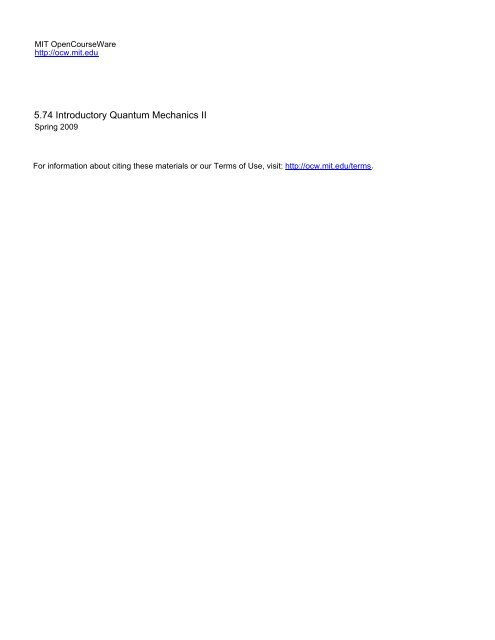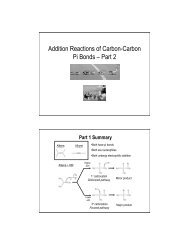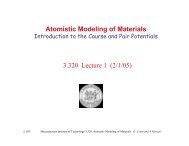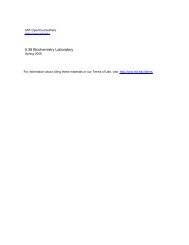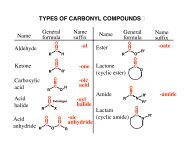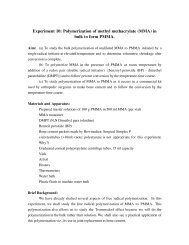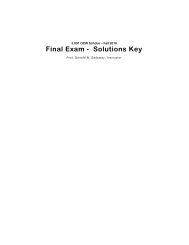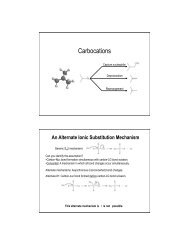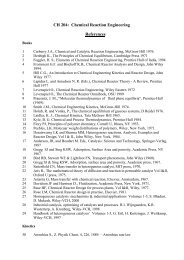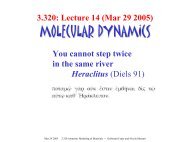5.74 Introductory Quantum Mechanics II - MIT OpenCourseWare
5.74 Introductory Quantum Mechanics II - MIT OpenCourseWare
5.74 Introductory Quantum Mechanics II - MIT OpenCourseWare
Create successful ePaper yourself
Turn your PDF publications into a flip-book with our unique Google optimized e-Paper software.
p. 10-16Feynman Diagrams 1Feynman diagrams are the easiest way of tracking the state of coherences in different timeperiods, and for noting absorption and emission events.1. Double line represents ket and bra side of ρ .2. Time-evolution is upward.3. Lines intersecting diagram represent fieldinteraction. Absorption is designated through aninward pointing arrow. Emission is an outwardpointing arrow. Action on the left line is actionon the ket, whereas the right line is bra.4. System evolves freely under H 0betweeninteractions, and density matrix element for thatperiod is often explicitly written.Ladder Diagrams 2Ladder diagrams are helpful for describing experiments on multistate systems and/or withmultiple frequencies; however, it is difficult to immediately see the state of the system during agiven time interval. They naturally lend themselves to a description of interactions in terms ofthe eigenstates of H 0 .1. Multiple states arranged vertically by energy.2. Time propagates to right.3. Arrows connecting levels indicate resonantinteractions. Absorption is an upward arrow andemission is downward. A solid line is used toindicate action on the ket, whereas a dotted lineis action on the bra.4. Free propagation under H 0 between interactions,but the state of the density matrix is not alwaysobvious.
p. 10-17For each light-matter interactions represented in a diagram, there is an understanding ofhow this action contributes to the response function and the final nonlinear polarization state.Each light-matter interaction acts on one side of ρ , either through absorption or stimulatedemission. Each interaction adds a dipole matrix element μ ij that describes the interactionamplitude and any orientational effects. 3 Each interaction adds input electric field factors to thepolarization, which are used to describe the frequency and wavevector of the radiated signal. Theaction of the final dipole operator must return you to a diagonal element to contribute to thesignal. Remember that action on the bra is the complex conjugate of ket and absorption iscomplex conjugate of stimulated emission. A table summarizing these interactions contributingto a diagram is below.KET SIDEInteractioncontrib.DiagrammatictoRepresentation ( )R ncontributiontok sig&ωsigAbsorption( ) expμba⋅ En ⎣⎡ ikn⋅r− i ωnt⎤⎦Enbabaμ ⋅ε + kn+ ωnbaˆnStimulated Emission(* ) expμba⋅ En ⎣⎡ − ikn⋅ r + i ωnt⎦⎤*Enbaabbaˆnμ ⋅ε − kn− ωnBRA SIDEAbsorption* *( μba ⋅ En ) exp ⎣⎡ − ikn⋅ r + i ωnt⎦⎤ba*Enbaμ ⋅ε ˆ − kn− ωn*banStimulated Emission*( μba ⋅ En ) exp ⎣⎡ ikn⋅r −i ωnt⎦⎤baEnabˆ*μba⋅εn + kn+ ωnSIGNAL EMISSION:(Final trace,convention: ket side)baabbaˆanμ ⋅ε
p. 10-19( ) = Tr ⎡⎣ μ (t) μ (0) ρ ⎤ eq ⎦= Tr ⎡μ Gˆ () t μρ ⎤C t⎣eq ⎦(10.2)This does not need to be known before starting, but is useful to consider, since it should berecovered in the end. The system will be taken to start in the ground state ρ aa . Linear responseonly allows for one input field interaction, which must be absorption, and which we take to be aket side interaction. We can now draw two diagrams:(4) Act on ket with μ and taketrace.(3) Propagate under H 0 :G ( τ ) = e −iω ba τ −Γabba τ .(2) Act on ket with μ(0) tocreate ρ ba .(1) Start in ρ aa (add factor ofp a when reading).With this diagram, we can begin by describing the signal characteristics in terms of the inducedpolarization. The product of incident fields indicates:− ω +ik ⋅r⇒ P ()e −iω sigt+ik sig rE e i 1 t⋅1t1(10.3)so that ω sig= ω 1k sig= k . (10.4)As expected the signal will radiate with the same frequency and in the same direction as theincoming beam. Next we can write down the correlation function for this term. Working frombottom up:(1) (2) (3) (4)() [ ]ba−iω ba t−Γ ba t [ ]C t = p aμ ⎡ ⎣e ⎤ ⎦μ ab(10.5)2 −iω ba t−Γ ba= p taμ baeMore sophisticated ways of treating the time-evolution under H 0 in step (3) could take the formof some of our earlier treatments of the absorption lineshape:
p. 10-21From the frequency conservation conditions, it should be clear that process i is a sum-frequencysignal for the incident fields, whereas diagrams ii-iv refer to difference frequency schemes. Tobetter interpret what these diagrams refer to let’s look at iii. Reading in a time-ordered manner,we can write the correlation function corresponding to this diagram asC = Tr ⎡μ τ ρ μ 0 ⎤2 ⎣ ( ) eq ( ) ⎦( ) bc cb ( ) ca ab ( )= −1 1 ∗μ Ĝ τ μ Ĝ τ ρ μ . (10.9)2 1=−p μ μ μ e −iω τ −Γ τ ea ab bc caaa−iω τ −Γ τab 1 ab 1 cb 2 cb 2Note that a literal interpretation of the final trace in diagram iv would implyan absorption event – an upward transition from b to c. What does this have to dowith radiating a signal? On the one hand it is important to remember that a diagramis just mathematical shorthand, and that one can’t distinguish absorption andemission in the final action of the dipole operator prior to taking a trace. The otherthing to remember is that such a diagram always has a complex conjugate associatedwith it in the response function. The complex conjugate of iv, a Q 2∗baket/bra term,shown at right has a downward transition –emission– as the final interaction. Thecombination Q 2− Q ∗2ultimately describes the observable.
p. 10-23Third-Order Nonlinear SpectroscopyNow let’s look at examples of diagrammatic perturbation theory applied to third-order nonlinearspectroscopy. Third-order nonlinearities describe the majority of coherent nonlinear experimentsthat are used including pump-probe experiments, transient gratings, photon echoes, coherentanti-Stokes Raman spectroscopy (CARS), and degenerate four wave mixing (4WM). Theseexperiments are described by some or all of the eight correlation functions contributing to R (3) :R ( )3 i= ⎛ ⎞3 4⎜ ⎟ ∑ ⎡R ⎣ − R* ⎤α α ⎦(10.10)⎝h⎠ α =1The diagrams and corresponding response first requires that we specify the systemeigenstates. The simplest case, which allows us discuss a number of examples of third-orderspectroscopy is a two-level system. Let’s write out the diagrams and correlation functions for atwo-level system starting in ρ aa, where the dipole operator couples b and a .R 1ket/ket/ketb aE 3E 2a ab aR 2R 3τ 1a ba bb aR 4bra/ket/bra bra/bra/ket ket/bra/brab ab ab ab ba ab bτ 3τ 2a aa aa aa aE 1ba+ ω − ω + ω − ω + ω + ω − ω + ω + ω + ω − ω + ω1 2 3 1 2 3 1 2 3 1 2 3k =+ k − k + k − k + k + k − k + k + k + k − k + ksig 1 2 3 1 2 3 1 2 3 1 2 3
p. 10-25rephasing.” Analysis of R 1and R 3reveals that these terms are non-rephasing and rephasing,respectively.phase acquiredφ0−iωba τ1eτ 1−iω ba τ 3eτ 3+iωba τ3enon-rephasingrephasingP()tt 1 t 2t 3tFor the present case of a third-order spectroscopy applied to a two-level system, weobserve that the two rephasing functions R 2and R 3have the same emission frequency andwavevector, and would therefore both contribute equally to a given detection geometry. The twoterms differ in which population state they propagate during the τ 2 variable. Similarly, the nonrephasingfunctions R 1and R 4each have the same emission frequency and wavevector, but differby the τ 2 population. For transitions between more than two system states, these terms could beseparated by frequency or wavevector (see appendix). Since the rephasing pair R 2and R 3bothcontribute equally to a signal scattered in the −k + k +k1 2 3direction, they are also referred to asS I . The nonrephasing pair R1and R4both scatter in the + k1 − k2+k3direction and are labeled asS <strong>II</strong> .Our findings for the four independent correlation functions are summarized below.S IS <strong>II</strong>rephasingnon-rephasingωsigR2ω1ω2ω3R3ω1ω2ω3R1ω1ω2ω3R4ω1ω2ω3ksigτ 2 population− + + − k1+ k2+ k3excited state− + + − k1+ k2+ k3ground state+ − + + k1 − k2+ k3ground state+ − + + k1 − k2+ k3excited state
p. 10-26Frequency Domain Representation 4A Fourier-Laplace transform of P (3) (t) with respect to the time intervals allows us to obtain an(3)expression for the third order nonlinear susceptibility, χ ( ω , ω , ω ) :P (3) ( )1 2 3ω = χ(3) ( ω ; ω , ω , ω ) E E E (10.16)sig sig 1 2 3 1 2 3where χ ( n ) ∞= ∫ d τ0eiΩ τ∞d e R(τ)( τ , τ ,Kτ ) . (10.17)n n iΩ11τ nnL∫ 01 1 2 nHere the Fourier transform conjugate variables Ω mto the time-interval τ mare the sum over allfrequencies for the incident field interactions up to the period for which you are evolving:m∑ ii=1For instance, the conjugate variable for the third time-interval of a +ksum over the three preceding incident frequencies Ω3 = ω1 − ω2+ ω3.Ω = ω (10.18)m− k1 2 3+k experiment is theIn general, χ (3) is a sum over many correlation functions and includes a sum over states:χ( 3 )1 i 3 4(ω , ω , ω = ⎛ ⎞ p ⎡6 ⎝h ⎠ abcd α = 1*1 2 3 ) ⎜ ⎟ ∑ a ∑ ⎣ χ χα −α ⎦⎤(10.19)Here a is the initial state and the sum is over all possible intermediate states. Also, to describefrequency domain experiments, we have to permute over all possible time orderings. Mostgenerally, the eight terms in R (3)of the time-ordering of the input fields. 5lead to 48 terms for χ (3) , as a result of the 3!=6 permutationsGiven a set of diagrams, we can write the nonlinear susceptibility directly as follows:1) Read off products of light-matter interaction factors.2) Multiply by resonance denominator terms that describe the propagation under H 0. In thefrequency domain, if we apply eq. (10.17) to response functions that usephenomenological time-propagators of the form eq. (10.1), we obtain1τm ρab⇒(Ωm −ωba ) − iΓ baĜ ( )Ω m is defined in eq. (10.18).. (10.20)3) As for the time domain, multiply by a factor of ( −1 ) nfor n bra side interactions.4) The radiated signal will have frequency ω sig= ∑ω iand wavevector k sig= ∑ k i.ii
p. 10-28Appendix: Third-order diagrams for a four-level systemThe third order response function can describe interaction with up to four eigenstates of thesystem Hamiltonian. These are examples of correlation functions within R (3) for a four-levelsystem representative of vibronic transitions accompanying an electronic excitation, as relevantto resonance Raman spectroscopy. Note that these diagrams present only one example ofmultiple permutations that must be considered given a particular time-sequence of incident fieldsthat may have variable frequency.R 1R 2R 3R 4ket / ket / ket bra/ket/bra bra/bra/ket ket/bra/brad aτ3d cd cb aE 3E 2c ab aEa aτ2τ1d ba ba aa ca ba ab bb aa adbdbdbdbcacacacaμ μ μ μ μ μ μ μ μ μ μ μμ μ μ μ* * * * * *ba cb dc ad ba da cb cd ba cb da cd ba da cd cbω =+ ω − ω + ω − ω + ω + ω − ω + ω + ω + ω −ω + ωsig 1 2 3 1 2 3 1 2 3 1 2 3= ωba+ωcb+ωdc= ωda−ωba+ωda −ωcb= ωdc−ωba −ωcb+ ωda=ωdcωba −ωda −ωcd= ωbcThe signal frequency comes from summing all incident resonance frequencies accounting for thesign of the excitation. The products of transition matrix elements are written in a time-orderedfashion without the projection onto the incident field polarization needed to properly account fororientational effects. The R 1 term is more properly written (μ ⋅ ˆ ε μ ⋅ ˆ ε μ ⋅ ˆ ε μ ⋅ ˆ ε .ba 1 )( cb 2 )( dc 3 )( ad an )Note that the product of transition dipole matrix elements obtained from the sequence ofinteractions can always be re-written in the cyclically invariant form μ μ μ μ . This is onefurther manifestation of closed loops formed by the sequence of interactions.ab bc cd da
p. 10-30Note that for the S I and S <strong>II</strong> signals there are two types of contributions: two diagrams in which allinteractions are with the v=0-1 transition (fundamental) and one diagram in which there are twointeractions with v=0-1 and two with v=1-2 (the overtone). These two types of contributionshave opposite signs, which can be seen by counting the number of bra side interactions, and haveemission frequencies of ω 10 or ω 21 . Therefore, for harmonic oscillators, which have ω 10 = ω 21and10 212μ = μ , we can see that the signal contributions should destructively interfere andvanish. This is a manifestation of the finding that harmonic systems display no nonlinearresponse. Some deviation from harmonic behavior is required to observe a signal, such asvibrational anharmonicity ω 10 ≠ ω 21 , electrical anharmonicity 2μ 10≠ μ 21, or level-dependentdamping Γ 10 ≠ Γ 21 or Γ 00 ≠ Γ 11 .1 . Yee, T. K. & Gustafson, T. K. Diagrammatic analysis of the density operator for nonlinearoptical calculation: Pulsed and cw responses. Phys. Rev. A 18, 1597 (1978)Fujimoto, J.G. and Yee, T.K., Diagrammatic Density Matrix Theory of Transient Four-Wave Mixing and the Measurement of Transient Phenomena. IEEE J. <strong>Quantum</strong> Electron.QE-22, 1215 (1986)Druet, S. A. J., Taran, J.-P. E. & Bordé, C. J. Line shape and Doppler broadening inresonant CARS and related nonlinear processes through a diagrammatic approach. J. Phys.40, 819 (1979).Mukamel, S. Principles of Nonlinear Optical Spectroscopy (Oxford University Press,New York, 1995).Shen, Y. R. The Principles of Nonlinear Optics (Wiley-Interscience, New York, 1984).2. D. Lee and A. C. Albrecht, “A unified view of Raman, resonance Raman, and fluorescencespectroscopy (and their analogues in two-photon absorption).” Adv. Infrared and RamanSpectr. 12, 179 (1985).3. To properly account for all orientational factors, the transition dipole moment must beprojected onto the incident electric field polarization εˆ leading to the terms in the table. Thisleads to a nonlinear polarization that can have x, y, and z polarization components in the labframe. The are obtained by projecting the matrix element prior to the final trace onto thedesired analyzer axis εˆ an.4. Prior, Y. A complete expression for the third order susceptibility χ (3) -perturbative anddiagramatic approaches. IEEE J. <strong>Quantum</strong> Electron. QE-20, 37 (1984).See also, Dick, B. Response functions and susceptibilities for multiresonant nonlinearoptical spectroscopy: Perturbative computer algebra solution including feeding. Chem. Phys.171, 59 (1993).5. Bloembergen, N., Lotem, H. & Lynch, R. T. Lineshapes in coherent resonant Ramanscattering. Indian J. Pure Appl. Phys. 16, 151 (1978).


